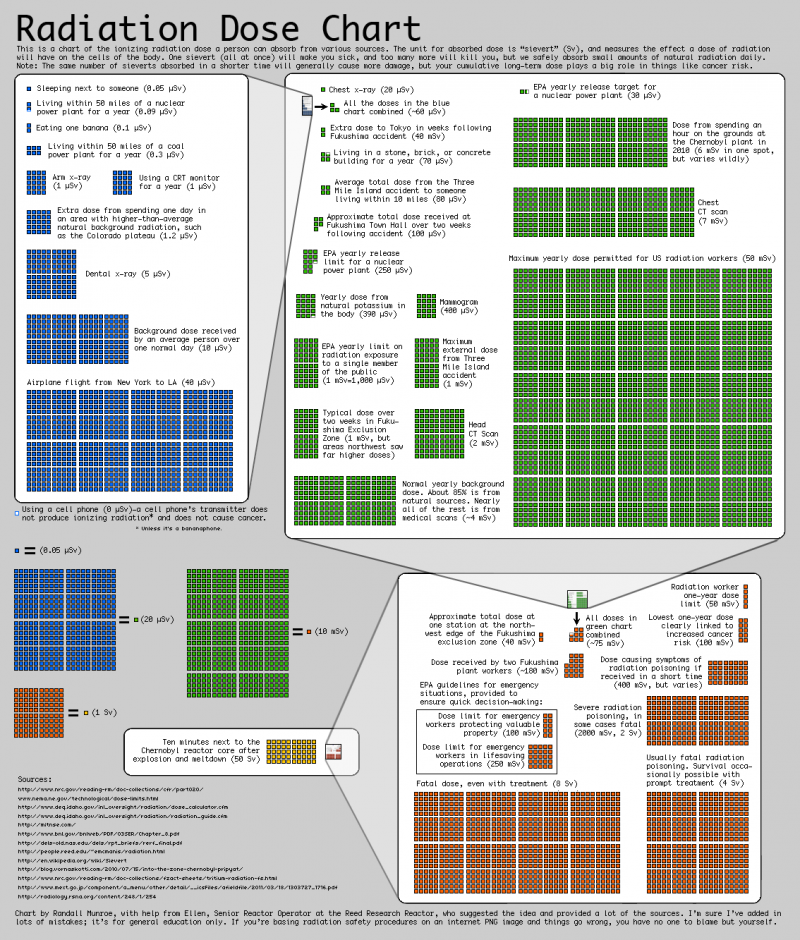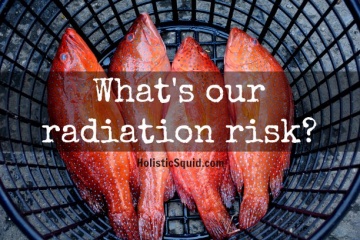
I recently wrote this post about the concerns about mercury in fish, only to learn that many of you are just as worried (or more so) about radiation in fish after the April 2011 disaster with Japan's Fukushima nuclear power plant.
Frankly, the information out there is conflicting and vague, but I've done tons of reading and here's what I've learned:
First, let's look at what we know about radiation in general:
According to Andrew Maidment, an associate professor of radiology at the University of Pennsylvania, the average person is exposed to 3 mSv (millisieverts) of ‘background radiation' every year from the sun, airplanes, and even eating bananas. The lowest dose known to cause cancer over a period of one year is about 100 mSv and the average amount of radiation that will cause immediate radiation poisoning is about 400mSv. (source)
Now you and I both know that individuals are different – so the amount of radiation it may take to create negative effects is going to vary from person to person depending on their overall health and constitution.
You can see more relative radiation exposure amounts in this infographic below.

The element most commonly discussed when it comes to fall out from nuclear accidents and weapon testing is caesium. Small amounts of caesium-134, caesium-137, and iodine-131 were released into the environment during nearly all nuclear weapon tests and some nuclear accidents, and are not otherwise produced in nature.
Whereas caesium-134 has a half-life of 2 years, caesium-137 has a half-life of 30 years and iodine-131 is 8 days, meaning it takes that long for half of the radioactive atoms in each substance to disintegrate. As such, caesium-137 is the radioactive isotope that is the biggest health concern in the current aftermath of Fukushima because it is the longest lasting threat.
Is radiation in fish a concern?
To put this into perspective when it comes to fish, let's look at the worst case scenario. According to this article from Japan Times, a fish caught directly in the Fukushima No. 1 nuclear plant’s small harbor contained 510,000 becquerels (bq) of radioactive caesium per kilogram – 5,100 times above the state-set safety limit. If someone were to eat to eat 2.2 pounds of a fish with this level of contamination, they would be exposed to about 7.7 mSv of internal radiation – the same amount of radiation as a chest x-ray.
That's pretty gnarly, and I'm definitely not interested in eating a chest x-ray worth of radiation for dinner. But, the fish we eat here in the U.S. does not come from the waters around the nuclear disaster site in Japan.
So then, you many have also heard that tuna was caught off the shores of San Diego, CA, that had traces of caesium that indicated that the fish had come from the waters around Fukushima. However, you'd need to eat 2.5 to 4 tons of that tuna in a year to get a dose of cesium-137 that exceeds health limits. (source)
Personally, that's a relief to me. I'd have to eat 6.8 pounds of contaminated fish per DAY for my consumption to be toxic.
Here's my take home about radiation in fish
Just like the rest of your food – know your source.
Buy wild caught fish that are not Japanese bottom-feeders (which you're not likely to find anyway).
IF you're in Japan, find out where the fish is from. In my opinion, the health benefits of seafood outweigh the risk of radiation poisoning.
What about radiation in the rest of our food supply?
There are tons of articles online about radioactive isotopes contaminating everything from seaweed to raw milk. Is this really something to worry about?
This report from UC Berkeley logs hundreds of records of testing for radioactive isotopes in U.S. air, water, plants, soil, and milk. Nearly all of their reports come back with nearly undetectable levels.
My raw milk producer here in Southern California – Organic Pastures – also had their milk tested and found that there were no detectable amounts of radiation. (source)
Personally, I find the issue around seaweed to be the most confusing as the U.S. imports plenty of seaweed from off the coast of Japan. U.S. companies go to great lengths to claim that their products are tested, though in combing the internet, I didn't find particularly recent reports.
This article claims they personally tested seaweed at high levels of radiation – however it does not actually provide measurements of radioactive isotopes present and they give percentages over ‘background'.
If radioactive isotopes are present in seaweed, how much of this extremely non-dense sea veggie would need to be consumed to create any damage?
The answer is unclear. For me, the risks of seaweed consumption are not compelling enough to not eat seaweed. This is the brand that I buy that stands by their testing.
Are you avoiding fish or seaweed because of the risk of radiation?










I live in Tokyo and my wife and I always choose wild salmon over farmed, and try and avoid seafood, vegetables and fruit originating from Fukushima/Ibaraki/Sendai. As you say, the benefits outweigh the risks.
thank you for this article. this issue weighs heavily on me, especially since I’m pregnant. I don’t eat much seafood as it is so I’m not specifically avoiding it (I take cod liver oil for the EFAs) but I’ve been more worried about local meat and dairy supply. which I can’t and won’t avoid so I’m left with hoping that the cumulative effect is tolerable. I appreciate the encouragement to just ask my producers if I have a question about testing rather than sit and wonder.
I agree with the Squid-a-roony on this one, too. Especially since our organic, fermented, superfood product contains algaes like spirulina & chlorella, and herbs like parsley and chicory root, which help to chelate (attract and bind) heavy metals for excretion through the bowels. Feel free to ask me about it or go to Organics For Free dot com to learn more.
Quite honestly, I have not been all that worried. Most of the fish we tend to eat is either wild-caught Canadian salmon or shell-fish.
But it is reassuring that there is nothing much to worry about.
Please do your own research about this ongoing nuclear disaster before you are reassured there is nothing much to worry about!
Agreed!!!
Thank you for doing some research. I am a busy mom of 8 and still nursing. I have been looking at origins of our fish and buy wild caught Salmon, sardines, and tuna fish. I also was very concerned about the toxicity of anything from our West Coast waters.
We have drastically cut our fish consumption. First the Gulf oil spill and then Japan. I dont trust any Govt reports to be accurate since they are covering their behinds. I worry the radiation is far greater than we know. I miss our seafood soooooo much.
Leah, I totally agree with you. The reports are not to be trusted in my opinion. Governments have a notoriously bad reputation for not telling us the whole truth. The fact that Fukushima is STILL leaking into the ocean should be considered as well.
I am still worried about the radioactive waste that has continued to pour into the Pacific for two years. There is no accurate timeline for this to be contained, either. And of course, the FDA raised the safe limits of radiation in meat shortly after the Fukushima disaster.
Hi Emily! Thank you for this awesome article! I am curious what you think about swimming & surfing in the Pacific ocean after conducting your research. I’m out there for two hours at a time almost daily in Southern California, and I’m not super worried but I have been thinking about it.
Hi Julie, thanks for your comment and question. Personally, I think it would be a problem if you were surfing around Fukushima. 😉 so wouldn’t be worried at all!
You say “a dose of cesium-137 that exceeds health limits”… Is that the health limit allowed by the Japanese equivalent of the FDA? Or is it the limit our FDA originally said was allowable and accepted as safe? Or, scarier, is it the limit the FDA changed it to after the Fukishima disaster? You know that our government allows a level of cesium 137 in our foods that is 100 times the limit allowed in Japan? And, that there is really NO “safe” level of cesium 137.
Yes, i would say my consumption of seafood has lessened (to nothing) and that I am concerned!
Hi Taylor – Thanks for your comment.
I wrote this post because I have the same concerns as you. I did not set out to prove that it’s safe to eat foods contaminated with radioactive isotopes, yet after spending hours doing research, I stand by what I’ve written above – at least until I discover credible information that sways me otherwise.
You are right that humans should not be consuming cesium at all – mostly because it is not an isotope found in nature and is the result of human error. That said, I could find nothing to show that radiation from one source acts differently in the body than another source, so the ‘safe’ levels of general radiation seem to apply to cesium just like they apply to radiation flying in an airplane or getting an x-ray.
I freely admit that I am not a fan of the FDA. However, my understanding is that the Japanese government made their levels more strict under the assumption that their people would be consuming contaminated foods on a regular basis. I have not come across information that the FDA raised the safe levels (though this would certainly not shock me). Regardless of whether we’re talking Japanese or U.S. safe levels, I still feel comfortable eating fish weekly because any contamination is extremely low.
If you have specific information that would shed a different light on this matter, please share it here. I welcome the discussion so that we can get to the bottom of the truth on this subject.
http://www.youtube.com/watch?v=nDgnBqBJZNc&feature=youtu.be
This video sheds additional light on the subject.
There are distinct differences in how radio-isotopes affect the body, including whether we’re exposed to (such as a chest x-ray or an airplane flight) as opposed to ingesting them. In terms of ingestion, Cesium is particularly harmful because it’s in the same Atomic Period as Potassium is and therefore mimics the macro-nutrient on a cellular level. Cesium-137 takes between 180 and 300 years to go away completely.
Another one to be concerned about is Strontium-90, which is in the same period as Calcium.
The other question is what the source of the food is. In particular apex predators and bottom feeders are affected. Bottom feeders, unless you’re eating imported clams or sole type fish from Japan, not so much an issue. Apex predators, such as Tuna, however, tend to migrate, so a Tuna caught off the CA coast last year (when the study was done) could have been in Japanese waters the year prior to that. The radiation levels also concentrate exponentially as we move up the food chain so that a Tuna could have accumulated 1,000,000 times the radio-isotopes that the surrounding water does.
It’s good to see an article that’s level headed about the situation. My particular concern is that the NRC, FDA, EPA and Tepco are not trustworthy. Tepco told us for two months after the earthquake that the reactors were fine, when in fact, 3 of the four had not only melted down, but had melted through their protective containment and have been leaking highly radioactive water at a rate of 300 tons per day ever since. That water is poised to start leaking into the ocean anytime (if it hasn’t already started) and there is no viable plan to stop it.
Recently they also announced that a container had leaked 300 tons as well, which water reached the ocean. This was initially rated as a level 1 nuclear incident, but the very next day was increased to a level 3 incident (which is 100 times more dangerous than a level 1 incident) as they “discovered” that maybe it was more than one, and probably more will begin leaking as the containers are not designed for permanent storage.
In the meantime, both the Japanese oversight agency and the EPA have raised the allowable radiation level in foods, clearly to protect businesses, not at all mindful of the public interest or health.
This is a complicated issue, and while it may not be as bad as the alarmists claim, I also have no level of trust in the pundits who claim there is nothing to worry about.
There is no such thing as safety limit, when it comes to radiation exposure which makes your heart thump irregular. Japanese government is hiding the fact and the US is aiding.
Alaskan salmon travels to Japanese cold water before they return for hatching for example and there is no compartments in our ocean. However there are a certain species of marine life that are not picking up the radiation as easily for some reason. Based on test catch info in Fukushima area, squid seems to be one of them. This type of molluscan does not have the same circulatory system as fish and this may perhaps be affecting them differently. I am not sure about this but my heart beat is the best test for radiation contamination of any food.
I hadn’t thought about it except in passing, but am really glad to know something now. I would have been more concerned if we still lived in Washington state, but then again the wild caught local or Alaskan fish there is probably much fresher and nicer than whatever we get shipped where we are now.
According to this we should be VERY concerned. And, yes, I am.
http://agreenroad.blogspot.com.br/2013/05/fukushima-radiation-measured-in-pacific.html
Well done! This is fair and balanced and real. I read Japanese and frequent Japanese blogs, gov’t sites and media – and a distillation, minus the fear mongering, comes down to exactly what you have written. Kudos for writing this with clarity of thought and mind. I think I’ll share this with my networks.
#gratitude
This ‘radiation is radiation’ mentality is absurd. You can’t make direct comparisons between flying in a plane or getting a chest x-rays and nuclear fallout.
When you’re flying in a plane you are getting mostly external radiation exposure. With an x-ray, you are exposed to radiation for a millisecond, and it is not ingested/inhaled.
Fallout radiation on the other hand accumulates and lingers in your bones and tissues for (potentially) decades.
The banana comparison is perhaps the most absurd. Our bodies always contain potassium 40; we’re born with it. If we consume more potassium 40 (e.g. if we eat a banana) our bodies will eliminate an equal amount (homeostasis). This is not the case with fallout radiation.
If we are going to tout the science behind the paleo diet, maybe we should also get behind the science in making specific dietary recommendations, such as eating potentially radioactive fish. Instead of “Oh, I don’t know how much radiation is in this fish, but I’m sure it’s safe to eat it because fish is sooo healthy!” how about something more like “Maybe we should take it easy on the pacific-caught fish until it is tested and we know what kind of effects it may have.”
I absolutey agree with David! I think anyone who eats fish from the waters of the Pacific Ocean at this time are asking for trouble.
Also, looking at radiation from a paleo/evolutionary approach, would you not intuitively say that we are quite capable of handling ‘normal’ amounts of natural radiation (such as solar radiation, esp. at high elevations, terrestrial radiation, etc.)? Much more so than human-created nuclear fallout?
If you’re interested in learning more, read this:
http://www.washingtonsblog.com/2013/04/fake-science-alert-fukushima-radiation-cant-be-compared-to-bananas-or-x-rays.html
Thanks for this post! It’s very timely as I’ve been thinking about this a lot lately. The mysterious recent sea lion deaths have me very concerned. It reminds me of the waning bee population… bees, sea lions- they are the “canaries in the coal mine” and we should take note that something is wrong. Thank you for all your time researching this. I’m torn because I know seafood is so healthy, but being right in the danger zone on the coast of Southern California, I think I will be consuming it sparingly until we know more. If it does turn out the be radiation causing the sea lions deaths, that’s all the evidence I need to avoid eating fish from the Pacific.
If you believe at all in the principles of homeopathy you would agree that even the smallest of dilutions can have an effect on the human body.
http://www.homeopathy-soh.org/research/evidence-base-for-homeopathy-2/basic-science/
Aren’t the risks cumulative though? Like the more exposure to radiation the more likely you are to have adverse health problems. So if I have regular mammograms, an x-ray for my teeth and then eat fish from the Pacific isn’t the exposure going to start adding up? Sure I’d have to eat a huge amount to get a lethal dose but over time aren’t I actually doing just that? I’m asking because I don’t know the answer to this question so if anyone can answer this I’d be interested to hear the answer.
You talk about the actual situation but with the meltdown of three reactors who will stay there for some time (how long? Nobody knows) you have to look for what the future will bring. The contemination of the ocean and ground water are great worries and if daily tons of conteminated water will be dumped into the ocean and this will go on for years …what will that mean? For the ground water it may result in the evacuation of Tokyo. For the oceans? Wo knows?
This info has been ‘out there’ for a while yet media (gov’t appear to) ignore this. Here’s a reputable source for important info- http://billmoyers.com/2013/11/15/what-you-need-to-know-about-fukushima/
Like most health topics: worrying about the possibility of a danger probably does more actual internal harm to one’s overall health than than the danger itself ever would. It’s almost like creating the damage/effect…whether or not actually experienced the damage. Undue excessive stress is too unhealthy.
NOTE: This is coming from someone (me) who worries about all sorts of things, way too much, and way too often. Just sayin’.
Hi,
Thank you for your findings and your summary. I agree that there is little concern for immediate radiation poisoning in one sitting or even over a year, but I am wondering about low dose radiation over a period of years? If it takes 60 years to breakdown, what happens after it builds up? And how many years can you eat small amounts of radiation before you see effects? Are there more subtle effects that occur at lower dosages?
Thank you for taking your time to do the research!
I recently came across information that, for one – shows how our tides and currents connect our oceans and that they have in fact found many many fish with large tumors, bloody cancerous masses, all linked to this issue. As a vegetarian, I don’t necessarily worry about these things often, but seeing the conflicting information made me want to ask.
Hi,
which Vitamin B medication that includes all B’s and folate for an MTHFR mutant do you recommend? I want sublingual because I heard its better absorbed than swallowing pill.
There are many types on Amazon but I want to know which one to take as some are missing some B vitamins.
Thanks,
Marianna